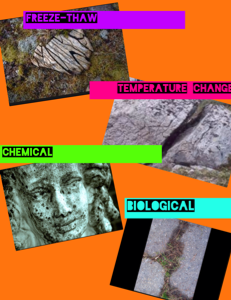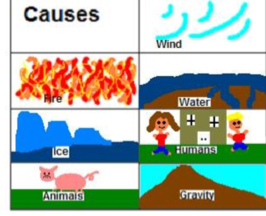Sign up for FlowVella
Sign up with FacebookAlready have an account? Sign in now
By registering you are agreeing to our
Terms of Service
Loading Flow

Weathering is different from erosion because there is no movement in weathering. In erosion, water, glaciers, or debri break off sediments but with weathering , it is just the rock breaking down either through mechanical or chemical erosion.
Erosion causes:
Water: when a river constantly flows through land, the water picks up sediments each time and erodes the land.
Wind: when a gust of wind comes, it picks up sediments and carries them through the air. This is slowly eroding the land.
Fire: as a fire burns it destroys plant material and the litter layer.
Glacier: when a glacier is falling, it clings onto lots of dirt and sediments which means it is eroding.
Weathering types:
Freeze-thaw: when water gets into cracks and freezes, leaving the water cracked. Then the ice melts causing the water to crack the rock even more.
Temperature change: when heat heats up a rock the rock expands very little. But when the rock cools back down it is going to contract. When this happens repeatedly it puts stress on the rock causing it to crack.
Chemical weathering: anything that is acidic will reAct with the mineral grains in the rock giving rise to new minerals in the rock.
Biological weathering: living things break apart a rock by growing or moving. A plants roots can break down a rock.
Erosion
Click me to view pictures

